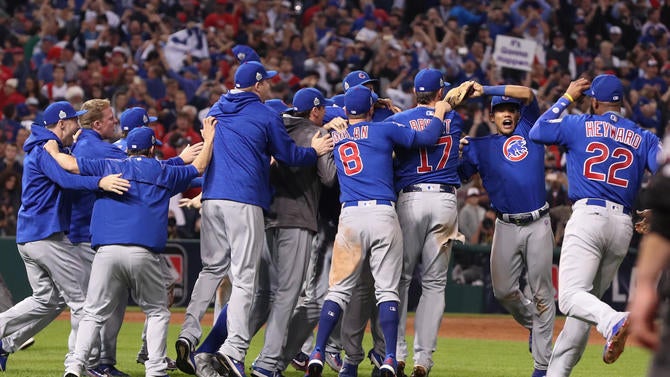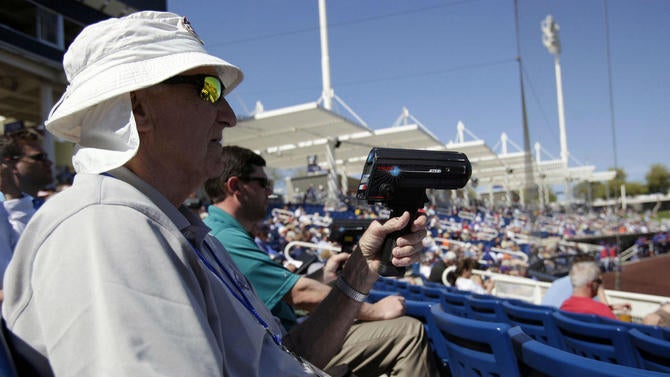Baseball's next Moneyball concept: Turning internet writers into prospect scouts
Teams have altered who they hire as scouts, tapping writers with backgrounds in advanced metrics

That Victor Wang was a hardcore baseball fan as a 16-year-old sounds like standard teenage fare. Except, unlike the normal teen, he was profiled in the New York Times due to his predilection for baseball -- specifically, his skills for examining and writing about the sport with an analytical bent. Wang peaked as a writer later on, producing his seminal works (studies concerning draft pick and prospect valuations) before he had finished his freshman year at Northwestern University. Both articles are widely referenced to this day, almost a decade since their publication in the Hardball Times.
The interim period has seen Wang graduate from Northwestern. However, it has not seen him author many new articles (his most recent byline at THT came in June 2009). His disappearance from the public eye can be traced to his acceptance into baseball. Wang was named the Cleveland Indians’ director of professional scouting in December, nearly four years after he was tapped as the assistant director, and some seven-plus years after he accepted his first internship with the organization.
“I basically sent emails cold to all teams asking them if they had any summer internship opportunities,” Wang told CBS Sports. “I had done some work prior to applying to teams with the Hardball Times and included a packet of my work with my résumé and cover letter. I was able to end up landing a summer internship with them and have been with them ever since.”
The Indians’ hiring of Wang made sense, given they’ve long been one of baseball’s most innovative teams. It was the Indians who patented long-term extensions for young players. It was the Indians who swam at the deep end of the data pool with the Oakland Athletics during the Moneyball era. It was the Indians whose creative bullpen usage last October led them to the pennant. Those unorthodox strategies all stem from the same root, the same truth -- the poor small-market Indians must act as a disruptor, as a tradition-eschewer, in order to compete with richer teams.
By stepping off line, the Indians have enjoyed plenty of on-field successes -- and, believe it or not, perhaps even more as the industry’s gatekeepers. Cleveland has produced general managers at a rate reminiscent of the old Expos. The key? Corporate shadiness. But, if the Indians have another key, it’s their willingness to challenge convention -- be it in the dugout or in the boardroom.
Put another way, Cleveland has a front office full of former writers: Assistant general manager Matt Forman is so fresh from the press box that his personal journalism website remains up -- complete with links to his archives at Baseball America and Lacrosse Magazine Online (really); Sky Andrecheck, the senior director of baseball research and development, starred at the now-defunct Baseball Analysts; then there’s Keith Woolner, a Baseball Prospectus vet with a befitting title: principal data scientist of baseball analytics.
In assembling what would be baseball’s most impressive masthead, the Indians have stepped into uncharted territory. Most teams employ a former writer or two on the research side -- baseball operations wonks who create databases, sift through numbers and run studies. The Indians have outpaced the league by doing the unthinkable: Entrusting ex-writers to run the scouting department. While Wang oversees the pro side -- think scouting minor leaguers -- the Indians’ amateur coordinator is Clint Longenecker, yet another former Baseball America staffer. The Indians appointed both without fear of rejection.
“Victor and Clint -- along with others across our baseball departments -- are incredibly passionate about the game, they’re relentlessly curious, and they have a deep desire to help those around them,” Forman said to CBS Sports. “They’ve helped lead our scouting departments by understanding and learning the challenges of the jobs and supporting our staffs, earning the respect of everyone across the organization.”
Examine the scouting staffs under Wang and Longenecker, and something becomes evident: So far as teams like the Indians are concerned, the prospect writer has become a prospect.

The new school
Let’s be clear about something: The Indians’ writers-turned-scouts are not the first to trade their digital recorders for radar guns. Throughout baseball history, scouting jobs (and most all front-office jobs) have been largely filled by ex-players. Yet exceptions have always existed. Bill Veeck’s father, William Veeck Sr., was a sportswriter before he was named president of the Chicago Cubs. The Toronto Blue Jays’ Kimball Crossley is a published children’s book author who majored in broadcast journalism and shared classes with S.L. Price (the Sports Illustrated guy) and James Surowiecki (the Wisdom of the Crowds guy).
Let’s be clear about something else: The Indians’ writers-turned-scouts are also not the first from their publications to make the leap. In the early 2000s, Baseball America graduated a trio (Alan Matthews, Josh Boyd and Chris Kline) to the majors; Baseball Prospectus saw Kevin Goldstein leave to take the Houston Astros’ pro scouting director job more than four and a half years ago. FanGraphs lost Kiley McDaniel to the Braves in October 2015; and so on.
What separates the Indians’ writers-turned-scouts -- and this new breed of prospect writer in general -- is this: They’re the first class who have entered baseball writing intent on becoming scouts.
Consider the stories of two Indians scouts, Steffan Segui and Ethan Purser.
Segui began defying convention when he was a high-school junior. One day, while taking in a Florida Gators game, he found inspiration in reliever Darren O’Day’s mechanics. “I remember watching him, and I thought, ‘Maybe I should try that,’” Segui said. He did -- and found throwing submarine agreeable. “It was kind of natural to me, for whatever reason.”
Segui’s new delivery landed him at Division II Mars Hill University. An injury would end his career, but he would earn a degree in business sports management at the University of North Florida, then follow O’Day’s cleat prints in another way by completing his masters at the University of Florida. All the while, Segui fed his baseball appetite with internships at various levels of organized ball -- at one stop, he even moonlighted on the media relations staff to make extra money. After a stint as a minor-league video coordinator ended in November 2013, he decided to try another path.
Purser’s introduction to scouting was different from Segui’s, but ended in the same place anyway. His playing career was derailed in high school due to injury and his passion for music -- he quit ball for a time to strum guitar in various bands. He wound up working in the sports information department at Berry College, where he majored in economics. Later, he wrote for Perfect Game, a scouting website that focuses on prep players, as well as for Capitol Avenue Club and Talking Chop, Atlanta Braves fansites for which he covered prospects. Although Purser was younger than many of the players he evaluated, he impressed more experienced baseball folk with his maturity.
“Ethan scouted like an old guy,” said longtime prospect writer Mike Newman, whose baseball relationship with Purser dates back to the latter’s teenage days. “He never got too excited about players. He was always very even about players. He actually graded to the more conservative guy. When he really took a chance on a guy, it was because he truly had a great feeling.”
Segui and Purser will each scout for the Indians this season, albeit in different ways. Segui is set to cover central Florida on the amateur level, meaning he’ll focus on potential draft picks. Purser will place eyes on various minor-league teams located in the southeast; his reports will help inform deadline and free-agent acquisitions. Both have Baseball Prospectus to thank for launching their careers -- particularly Jason Parks, once BP’s lead prospect writer.
“I had always wanted to get into scouting. I just didn’t know how,” Segui said. “I saw Parks had tweeted out, ‘Hey, looking for guys to write about prospects,’ and I had seen hundreds that year while doing my player development stuff and the fall league. I figured I was kind of free, and that this would be a good opportunity to get some scouting experience, just get my name out there.”
Neither lasted long at BP after joining. Segui latched on with the Indians as a video/associate scout by the time the ensuing season arrived. Purser, on the other hand, joined the Rays as an associate scout before 2015. This will be his first year with the Indians.
As for Parks? The Indians have a connection with him, too: just last October, they lost the World Series to his employer.

The game-changer
Though Parks (now with the Chicago Cubs as a special assistant to the GM/president) declined comment for this story, his supposed effect on prospect writing leaves him sounding like an outsized legend -- some kind of Johnny Applescout.
A conceptual art student in college, Parks took an interest in the Texas Rangers’ farm system while working at a New York-based advertising firm called Agent 16. Parks didn’t own a car, but three or four times a week he would take buses to various minor-league games. At the appropriate times of the year, he would use his sick days and vacation time to fly to Arizona, where he would catch spring and instructional league action on the back fields. He took to writing on Baseball Time in Arlington, and became a go-to resource for other prospect writers hoping to get the goods on Texas’ loaded system. Eventually, he made his way to Baseball Prospectus, where he co-hosted the Up and In podcast with Kevin Goldstein. Once Goldstein left for the Astros, Parks became BP’s lead prospect writer -- and that’s when things got interesting.
BP overhauled its prospect coverage under Parks’ watch. In contrast to Goldstein, who had served mostly as a conduit, channeling information from his extensive network to the public, Parks placed an emphasis on first-hand accounts -- an emphasis on being an evaluator (one source noted Parks would often say he felt he was more of a scout than a writer). He assembled what came to be known as “the prospect team,” a group of writers stationed across the land, strategically located to cover as many leagues and levels as possible, who could provide the eyewitness accounts he couldn’t. Essentially, Parks wanted his bunch to act as the scouting wing of a team, one that would publish its reports using industry-like reports and lingo.
BP uses both the team and report structures to this day, signaling they deemed Parks’ experiment a success. Others have, too. Most everyone interviewed for this article agreed that first-hand reports have gained in popularity in prospect writing over the past several years.
“I think you do have a lot more people who are going to games and telling you what they saw,” Kevin Goldstein said, “and some of them are really good at it -- some of them know what they’re looking at … not all of them do, but a good number of them do.”
“Parks’ approach struck a chord with the readership because he really emphasized in-person views and the value that that provides,” said Craig Goldstein (no relation to Kevin), BP’s minor-league editor. “I think that was a shift. Even if you go back to Kevin Goldstein -- and this was all just strictly at BP -- but it’s kind of representative of the industry at large.”
“Whereas five, 10 years ago you had people covering prospects as a beat, now you have people going in and trying to show they can evaluate,” Purser said.
Given how many members of the prospect team have been plucked by organizations since its inception, it seems that executives approve of Parks’ vision right alongside readers and fellow writers. In addition to Segui and Purser, folks familiar with prospect writing might know about the hirings of Tucker Blair and Ronit Shah (Astros), Jason Cole and Tim Steggall (Rays), Zach Mortimer and Mauricio Rubio (St. Louis Cardinals), Josh Herzenberg (Los Angeles Dodgers), Al Skorupa (Oakland Athletics) and Brendan Gawlowski (Milwaukee Brewers). The churn hasn’t stopped just because Parks is gone, either -- Craig Goldstein said that this most recent offseason saw six members of the prospect team hired as scouts or interns.
People are becoming writers with the intent to become scouts, are acting as scouts while they’re writing and are later becoming scouts. But why are teams going along with it, again?

Somebody’s watching
The most obvious takeaway from the past few years is that teams are paying attention.
“Every day you’re doing this, if you’re one of the online people, you’re putting your résumé out there. And the risk is you can go, ‘Look, John Doe wrote something really, really stupid.’ The reward is -- you know, teams read this stuff,” Kevin Goldstein said. “They read BP, FG and THT, and the mainstream sites as well -- MLB Trade Rumors, all that stuff. The reward is they look at that really smart thing John Doe wrote.”
Various front-office members described prospect writers’ work as a portfolio of sorts -- one that can reveal how the writer scouts, how the writer thinks and how the writer learns from past mistakes. Besides, any individual willing to put up with the poor pay (writers polled for this piece estimated they made between $15 to $25 per post, upwards of $100 a month, and everywhere in between) and the never-ending travel for years on end must truly love baseball -- and, moreover, must truly love the idea of scouting. Alfred Russel Wallace would be proud.
“Having a public portfolio not only can show a front office someone’s general scouting feel,” Wang wrote, “but it also helps a candidate show strength in a number of other areas that are correlated to a candidate’s success such as work ethic, interest and curiosity in seeing games and evaluating players, and a forward-thinking mindset.”
Other evolutionary aspects are at play, too. Those writers with nontraditional backgrounds who make it far enough in the prospecting world must, by rule, have the necessary skills to learn and adjust. That’s not to mention the confidence -- sometimes bordering on self-delusion -- necessary to post opinions online, where every Tom, Dick and Twitter egg can sound off about how wrong the writer is -- all without ever seeing the player for themselves.
But admiring a writer’s passion and willingness to withstand criticism isn’t the same thing as hiring the writer to scout. What caused teams to open their minds toward this subset?
“When you start putting people in power who didn’t have that old-school upbringing, in terms of baseball and the game, it’s going to bring different hiring practices,” Craig Goldstein said. “One of the most common things in hiring is people hire people who remind them of themselves. So if you’ve got a scouting director who maybe didn’t play baseball in college or in the minors, they’re going to be more open-minded about who they hire as scouts.”
Sure enough, teams like the Indians and Rays -- teams who are believed to employ the most writers-turned-scouts -- don’t have ex-players in traditional power positions. In fact, fewer and fewer teams do. This generation of GMs grew up reading Moneyball -- and, if they learned anything from Paul DePodesta’s inclusion, it might be that outsiders can provide important perspectives that can be lost on those who are entrenched in the culture and its tradition.
“The game today is heading toward teams valuing information in whatever manner they can acquire that information,” Purser said. “We’re heading toward a spot where more information is better. It comes back to what they say in Dollar Sign on the Muscle: The term ‘scout’ comes from a French term that means ‘to listen.’ People with different backgrounds, whether it be in writing or whatever ... they have trained that skill in their former trade.
“That ability to listen, to gather as much information, and to disseminate it to their superiors so they can make the best decisions. I think that’s a skill that’s really highly valued, and I think that’s why you’re starting to see some of these writers put into positions like this.”
Is it fair to write, then, that teams have warmed up to the writer scout? Sort of.
“Yes. It’s just more common in who you see at the ballpark. But ‘warming up to’ comes on an individual basis,” Texas Rangers assistant GM and former Baseball America staffer Josh Boyd wrote in an email to CBS Sports. “If you treat people with respect, you earn respect. If you come in thinking you have all the answers, good luck. That goes for any industry, I’m sure.
“I think warming up is earned by behavior, habits, work ethic and ultimately production. And yes, scouts from nontraditional backgrounds are checking those boxes.”
“I don’t know if there is a single individual reason for this,” Wang wrote. “But I think a few reasons could include: 1. growing scouting staffs, especially at the amateur and international levels; 2. improving development processes for scouting departments; and 3. some copycatting. Like in many domains, it is likely easier to do something nontraditional after it happens for the first time.”
Not everyone believes teams are hiring writer scouts for idealistic reasons, however. Some sources speculated the real reason behind the hiring frenzy has to do with cost. The thinking goes like this: Teams can hire two youngsters for the price of one experienced scout. Favoring efficiency over experience would seem like a questionable call -- especially given the importance of the role -- but it’s one that has happened at the managerial level. Others pointed to different, if still cynical reasons for teams’ shifting philosophies.
“I think there’s a couple of factors,” wrote Christopher Crawford, who used to write for BP and ESPN, and now writes for Rotoworld and Hero Sports. “On one hand you might say that it has to do with the open-mindedness of front-office guys. I actually think it’s the opposite. I think it’s easier to get an internet scout -- for lack of a better term -- to get on board with the advanced stats/different ways of applying the 20-80 scale than it is former players, and I do think that’s a factor. The biggest thing for me is that it’s been done and been done successfully, and this is a league full of copycats. But I think there’s more groupthink than people anticipate.”
Rest assured that not every “internet scout” is getting hired based solely on their online work. Sometimes these hirings are based on old-fashioned things, like pre-existing relationships and shared working experiences. Atlanta Braves general manager John Coppolella noted in an email that Kiley McDaniel had interned for him during their days with the New York Yankees. “It didn’t hurt him or anything,” Coppolella wrote of McDaniel’s work online, “but we hired him because we felt he would make us better.“
The factors listed above help explain why teams are open to hiring prospect writers as scouts. But what about the prospect writers who don’t want to become scouts? As it turns out, teams want to hire them, too.

The hobbyist scouts
“The lure of the championship ring is strong. But the idea of [messing] up my marriage because I’m on the road two-thirds of the time is not ideal,” said Eric Longenhagen, FanGraphs’ lead prospect writer. “There are a lot of things right now that have me leaning away from working for a team, and most of them are fear-based. But I like writing a lot. I haven’t been doing this for full-time for even a year yet and I’m excited to continue to grow and see what I can do in a niche job that very few people actually have. “
Longenhagen never played baseball growing up. He doesn’t have youth notebooks that hinted at a future in prospecting, either. But he was always interested in player evaluation and development -- particularly after he read Moneyball. It wasn’t until Longenhagen served as an usher for the Philadelphia Phillies’ Triple-A team that he developed an appreciation for scouting. He would often arrive early -- not to wipe down seats, but to take in batting practice and talk with the scouts. Even so, his entrance into writing was by necessity, lest he risk losing all his friends.
“I had mono and got bored and made my Blogspot site. I was posting thoughts about players and stuff on Facebook, which ... I was not a competent Facebook user. Like everyone else, I had thought Kel Mitchell had died several times. But one of my high school friends said, ‘This is annoying, how about you just start a blog and do it there so that way if I don’t care what you think about Mike Sisco, I don’t have to see it?’ And so that’s how I started writing.”
Longenhagen might not have a strong desire to work for a club, but that might not matter. The winter meetings rumor mill had him enduring a lengthy interview with a team known for hiring internet writers as scouts. Longenhagen confirmed as such during a phone call, noting it was the most serious discussion he has ever had with an organization. The individual the team eventually hired, by the way? A different former internet prospect writer.
Mike Newman, who used to write at FanGraphs and now works with technology in education, also interviewed for a scouting position this winter. He was edged by a pair of former big-league players. A collegiate catcher who idolized Joe Girardi as a youth, Newman thought he might get drafted before he hurt his arm. Nonetheless, he says he never thought about becoming a scout until, well, he was done with scouting, mostly due to his family commitments.
“Teams want young people with very few ties. They want people who would be willing to travel 300 days,” Newman told CBS Sports. “I was very cognizant of the fact that the only way that I could scout was if I had a team that thought I was good enough to cater to my family and some of my scheduling needs. I was also cognizant of the fact that, why would they ever do that with a thousand other people in line behind me to get a scouting job? I’m not that [freaking] special.”
Newman ultimately bowed out of prospect writing for the same reason, having realized his personal site, RotoScouting, wouldn’t be viable for at least five years. “It was one of those things where I thought, ‘Man, if I could just make 40 [thousand] a year leading prospect coverage for one of these majors site, then I would be the luckiest and happiest person alive.’”
Much like how scouts are willing to traverse back roads to find a hidden gem, teams are willing to look beyond the national stage to find talented prospectors.
“I’m not gonna drop his name here. I might not want to get him too noticed, even,” Kevin Goldstein said. “But there’s a guy who’s not on the national scene at all, he writes about one team’s prospects -- I think he’s the smartest guy out there. It’s Matt Winkelman, he writes about the Phillies. You read him and you’re like, ‘This guy gets it.’ You know, go ahead and drop his name. I’m fine with it; he deserves it.”
Winkelman is a 26-year-old IT worker with degrees in physics and history. He was the team manager of his middle-school softball team, but otherwise has no real playing experience. Though he lurked in online comments sections, he didn’t start writing about baseball until an unemployed stretch in 2012. Once he joined Phuture Phillies, it wasn’t long until he took over the site. Recently, he became the managing editor of Crashburn Alley.
“I have not actually seen a Phillies minor-league game in person since I started writing,” Winkelman wrote in an email to CBS Sports. “I try to talk to everyone I can, whether it is scouts, public-facing prospect writers, or just fans who are at games, everyone can offer something.”
Winkelman doesn’t have the typical scout’s background, and he doesn’t consider an industry gig as his endgame (“I have always written for myself because I enjoyed baseball and I wanted to continue to learn more”). Still, his resourcefulness inspires recollection of classic scout stories about the lengths they’ll go to get a leg up -- be it talking to the school janitor, hiding in the bushes or whatever else is necessary to find out more about a player.
“You can’t scout a minor-league radio broadcast, but it will tell you whether a batter is being aggressive or passive at the plate, or if the pitcher is constantly missing up with his curveball. You may not trust a fan to project a player for you, but they may tell you that a pitcher was laboring and missing his spots or that he was working on his changeups that day. The best way to scout is in person, so without that it is important to recreate as much of that experience as I can.”

For better or worse
The looming question for everyone involved is how this new trend has and will continue to impact both prospect writing and scouting. As with most things in baseball, and with life, the outlook depends on the source.
None of the new-era scouts or prospect writers interviewed for this piece said they had ever felt animosity from older scouts; in fact, all of them credited traditional scouts for being helpful. It stands to wonder whether that will remain true if the gates continue to open, costing more and more traditional scouts their jobs, much as the influx of Ivy Leaguers to front offices have. As important and romantic as the job is -- watching baseball games every day, hoping to find that hidden superstar -- it’s equally as thankless and difficult. Scouts are mostly working on year-to-year agreements, affording them precious little job security. More candidates means more competition, which in turn means more turnover and unemployed scouts.
Prospect writers can relate to the ill effects of increased competition, since it impacts everyone’s ability to form the source networks that used to serve as the backbone for job.
“The explosion of social media and other websites covering has certainly clouded the picture somewhat on prospect list credibility ... because it’s overloaded,” Boyd wrote. “I feel fortunate that I got in at a time when I may have been one of the very few to reach out to a scout or front office and connect with someone like Jason McLeod, then in the Padres player development department, to bug him about Dennis Tankersley and Jake Peavy, and I think because [Baseball America] was one of the few in the game at the time it may have been easier to build relationships.”
The increased competition has caused some other negatives, too.
“There’s a lot more of it, that’s for sure,” Crawford wrote. “And I think it’s become a lot more contentious. Maybe that’s just because I’m paying more attention, but when I started it didn’t seem like this was a competition; just different people seeing different things in players, and in some cases using different applications to do so. Now, it seems like it’s a contest to be right about a player, and the hotter the take on the player, the better. That’s not something I love, but that’s the way it appears to be going.”
“It probably wound up costing me a career because I didn’t mix a bunch of dick and fart jokes into my writing. I didn’t worry so much about being a personality who did scouting. I worried about being the best prospect evaluator writing, period.” Newman said.
There are positives to this “revolution,” too. Opening the door to individuals who might have been locked out otherwise is a good thing -- and one that, in theory, should lead to greater diversity, the baseball industry’s most glaring problem. That increased difficulty in standing out can also lead to innovation. Be it Parks’ prospect team invention, or through better use of technology -- Newman, for instance, claims to be the first person in the scouting section who he ever saw deploy a video camera. These days? YouTube hosts footage of most every big-name prospect -- just clicks away for anyone to access.
Ultimately, the desire to win is what drives organizations to experiment. But encapsulated in that desire is the need for new ideas -- and those can come from the most unlikely places.
“During my first year with the Indians, in our pre-draft meetings, I was sitting at one of the back tables listening to the discussion, so intrigued to learn about the group’s thoughts on players we were going to take just days later. We would take breaks in the meeting every so often, and at various points throughout those meetings, Mark Shapiro, Chris Antonetti and Mike Chernoff made a point of saying something to the effect of, ‘We’re looking for the best ideas, regardless of where they come from,’” Forman wrote. “Title, intern or otherwise, wasn’t relevant. We just wanted to gather the most creative thoughts from the group to make the best collective decisions for the organization -- irrespective of background.”
In that sense, what teams are doing in hiring these unusual candidates is simply scouting in its purest form.

















